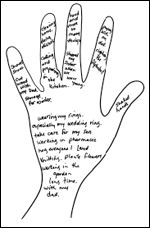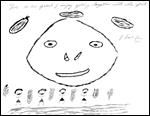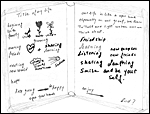

One of the women drew a large heart but it was not intact. After drawing activities like this one, it was crucial to have time for women to either share their feelings with the group, or to sit quietly without having to explain their emotions. In my role as the facilitator, I needed to have a sense of how the group members felt to ensure that the appropriate action and response followed.

In another drawing exercise, participants outlined one or both of their hands on paper and listed all the things their hands had done over the years. This was a way to reflect on life situations, recall memories—both pleasant and unpleasant—and to begin sharing particular feelings. For some participants, this exercise also reinforced special capabilities that may have been forgotten, such as working in a pharmacy. In one example, the participant spoke of shoveling snow, cutting firewood with her father for winter, taking care of her son, slapping her sister, planting flowers and shaking hands, among other activities.
In a painting activity, I invited women to paint the answer to the question, "What does this group mean to you?" Participants' paintings encouraged conversation and discussion about the support network they had established with one another.